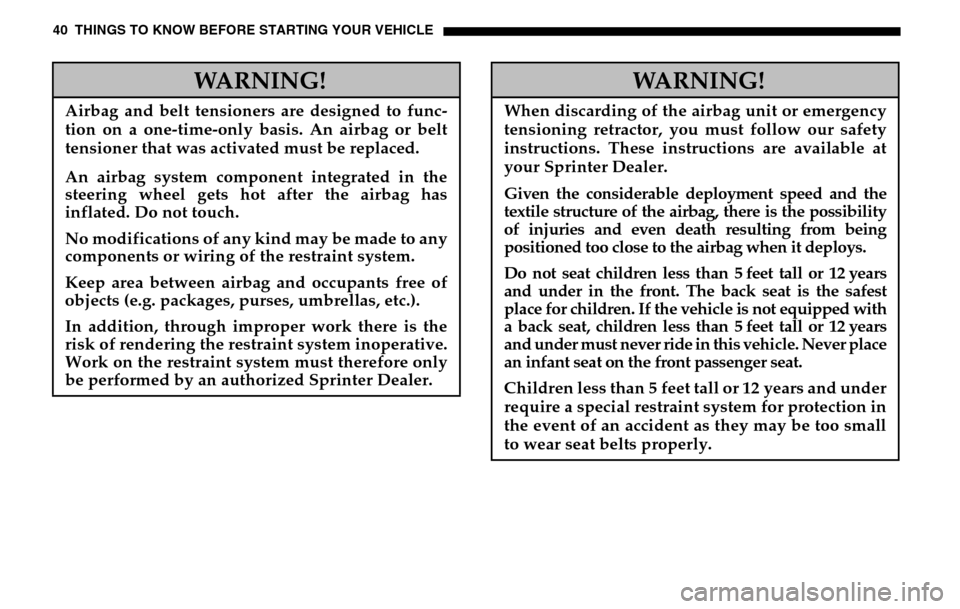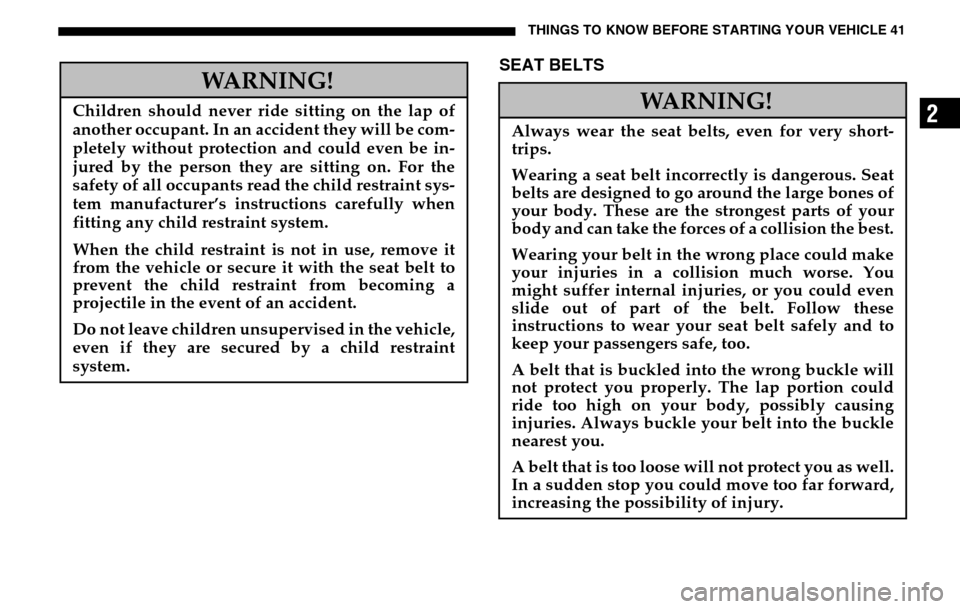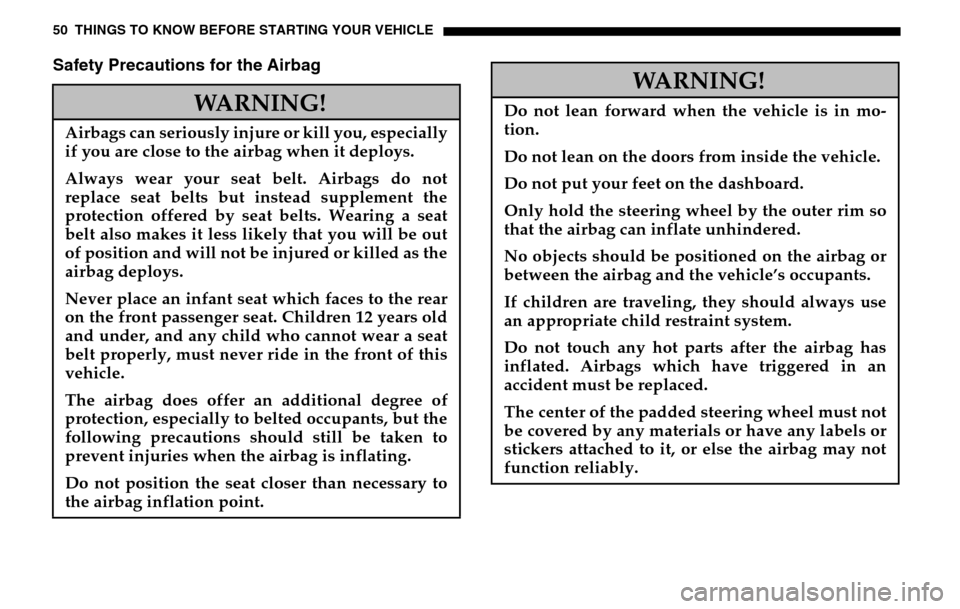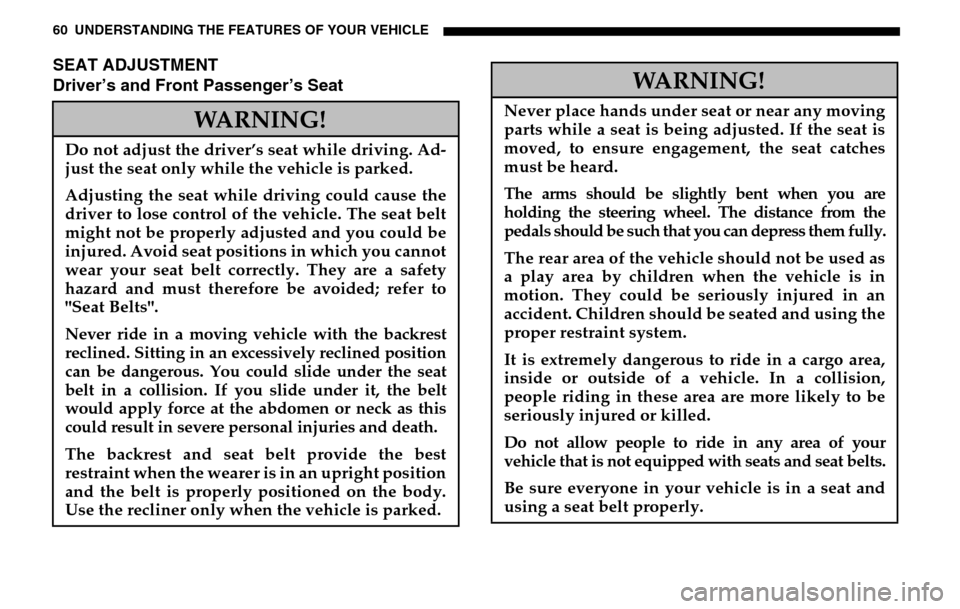child restraint DODGE SPRINTER 2005 1.G Owners Manual
[x] Cancel search | Manufacturer: DODGE, Model Year: 2005, Model line: SPRINTER, Model: DODGE SPRINTER 2005 1.GPages: 288, PDF Size: 27.89 MB
Page 16 of 288

16 THINGS TO KNOW BEFORE STARTING YOUR VEHICLE
Unlocking:If a door lock or interior handle on the driver or front
seat passenger door is unlocked, only the driver or
front seat passenger door will be unlocked.
NOTE: If a door lock or interior handle on the sliding
door or tailgate is unlocked, only the sliding door or
tailgate will be unlocked.Locking:All doors are automatically locked if a door lock or
interior handle is locked.
NOTE: If the central locking automatically unlocks
again after having been locked, at least one door is
closed incorrectly.
If it then locks again within about 5 seconds, then all
closed doors are locked.
The central locking displays vehicle locking with one
or more open doors by means of a special function
sequence (locking, unlocking, locking). Once closing
has been completed, an open door will not
automatically be locked.
WARNING!
When leaving the vehicle always remove the key
from the ignition lock, and lock your vehicle. Do not leave children unsupervised in the vehicle,
even if they are secured by a child restraint system.
The children could• injure themselves on parts of the vehicle
release the child-proof locks by pressing the central locking button and could thereby open
the doors and
cause injury to others as a result
get out of the vehicle and could either injure themselves when doing so or they could be
injured by the traffic approaching from the rear
suffer serious or fatal effects in the event of long periods of hot weather
release the parking brake. The vehicle could then start moving of its own accord.Unsupervised use of vehicle equipment may cause
severe personal injuries, death and property damage.
Page 18 of 288

18 THINGS TO KNOW BEFORE STARTING YOUR VEHICLE
Locking Status DisplayLeft-hand indicator lamp is illuminated:
The driver’s door is locked.
Right-hand indicator lamp is illuminated:
Front-seat passenger door and rear-seat passenger
area/cargo area are locked.
Both indicator lamps are illuminated:
The entire vehicle is locked.
If an indicator lamp flashes:
At least one door has not been properly closed.
NOTE: The indicator lamps go out,
once the remote keyless entry transmitter has been
used to completely lock the vehicle;
if the ignition lock is in the position 0, and once the
interior handles/closing cylinders have been used to
completely lock the vehicle;
after about 15 minutes in position 0 in the ignition lock.
The display can be reactivated by pressing the central
locking switch, located on the center section of the
dashboard.
WARNING!
When leaving the vehicle always remove the key
from the ignition lock, and lock your vehicle. Do not leave children unsupervised in the vehicle,
even if they are secured by a child restraint system.
The children could• injure themselves on parts of the vehicle
release the child-proof locks by pressing the central locking button and could thereby open
the doors and
cause injury to others as a result
get out of the vehicle and could either injure themselves when doing so or they could be
injured by the traffic approaching from the rear
suffer serious or fatal effects in the event of long periods of hot weather
release the parking brake. The vehicle could then start moving of its own accord.Unsupervised use of vehicle equipment may cause
severe personal injuries, death and property damage.
Page 27 of 288

THINGS TO KNOW BEFORE STARTING YOUR VEHICLE 27
2
The vehicle will be centrally locked if all doors are
closed.
Switching Off the Alarm and Unlocking the Vehicle
Press the alarm pushbutton up one more time.
The vehicle will be centrally unlocked if it was not
centrally locked before the alarm was manually
triggered.
OPENING/CLOSING DOORSFront Doors
WARNING!
Do not leave children unsupervised in the vehicle,
even if they are secured by a child restraint sys-
tem. The children could
injure themselves on parts of the vehicle
release the child-proof locks by pressing the central locking button and could thereby open
the doors and
cause injury to others as a result
get out of the vehicle and could either injure themselves when doing so or they could be
injured by the traffic approaching from the rear
suffer serious or fatal effects in the event of long periods of hot weather
release the parking brake. The vehicle could then start moving of its own accord.Unsupervised use of vehicle equipment may cause
severe personal injuries, death and property damage.
Page 39 of 288

THINGS TO KNOW BEFORE STARTING YOUR VEHICLE 39
2
OCCUPANT RESTRAINTSSeat belts, belt tensioners, airbag and child restraint
systems are independent restraint systems whose
functions complement each other.
All states and provinces require use of child restraints
that comply with U.S. Federal Motor Vehicle Safety
Standard 213 and Canadian Motor Vehicle Safety
Standard 213.
All child restraint systems are designed to be secured
in vehicle seats by lap belts or the lap belt portion of a
lap-shoulder belt.
For your safety and that of your passengers, you must
use the seat belts and child restraint systems and use
them properly. We strongly recommend their use.
WARNING!
In a collision, you and your passengers can suffer
injuries, including fatalities, if you are not proper-
ly buckled up. You can strike the interior of your
vehicle or other passengers, or you can be thrown
out of the vehicle. Always be sure you and others
in your vehicle are buckled up properly.
WARNING!
Do not modify the components or electrical wir-
ing of the restraint systems. This includes the in-
stallation of additional trim material, badges etc.
over the steering wheel hub, or front door trim
panels, and installation of additional electrical/
electronic equipment on or near restraint system
components and wiring.
Any work on the restraint systems should only be
carried out by an authorized Sprinter Dealer.
Unprofessional work can lead to the restraint
systems triggering incorrectly or failing.
Damaged seat belts or belts that were highly
stressed in an accident must be replaced and their
anchoring points must also be checked. Use only
belts installed or supplied by an authorized
Sprinter Dealer.
Do not pass belts over sharp edges.
Do not make any modification that could change
the effectiveness of the belts.
Page 40 of 288

40 THINGS TO KNOW BEFORE STARTING YOUR VEHICLE
WARNING!
Airbag and belt tensioners are designed to func-
tion on a one-time-only basis. An airbag or belt
tensioner that was activated must be replaced.
An airbag system component integrated in the
steering wheel gets hot after the airbag has
inflated. Do not touch.
No modifications of any kind may be made to any
components or wiring of the restraint system.
Keep area between airbag and occupants free of
objects (e.g. packages, purses, umbrellas, etc.).
In addition, through improper work there is the
risk of rendering the restraint system inoperative.
Work on the restraint system must therefore only
be performed by an authorized Sprinter Dealer.
WARNING!
When discarding of the airbag unit or emergency
tensioning retractor, you must follow our safety
instructions. These instructions are available at
your Sprinter Dealer.Given the considerable deployment speed and the
textile structure of the airbag, there is the possibility
of injuries and even death resulting from being
positioned too close to the airbag when it deploys.
Do not seat children less than 5 feet tall or 12 years
and under in the front. The back seat is the safest
place for children. If the vehicle is not equipped with
a back seat, children less than 5 feet tall or 12 years
and under must never ride in this vehicle. Never place
an infant seat on the front passenger seat.Children less than 5 feet tall or 12 years and under
require a special restraint system for protection in
the event of an accident as they may be too small
to wear seat belts properly.
Page 41 of 288

THINGS TO KNOW BEFORE STARTING YOUR VEHICLE 41
2
SEAT BELTS
WARNING!
Children should never ride sitting on the lap of
another occupant. In an accident they will be com-
pletely without protection and could even be in-
jured by the person they are sitting on. For the
safety of all occupants read the child restraint sys-
tem manufacturer’s instructions carefully when
fitting any child restraint system.
When the child restraint is not in use, remove it
from the vehicle or secure it with the seat belt to
prevent the child restraint from becoming a
projectile in the event of an accident.
Do not leave children unsupervised in the vehicle,
even if they are secured by a child restraint
system.
WARNING!
Always wear the seat belts, even for very short-
trips.
Wearing a seat belt incorrectly is dangerous. Seat
belts are designed to go around the large bones of
your body. These are the strongest parts of your
body and can take the forces of a collision the best.
Wearing your belt in the wrong place could make
your injuries in a collision much worse. You
might suffer internal injuries, or you could even
slide out of part of the belt. Follow these
instructions to wear your seat belt safely and to
keep your passengers safe, too.
A belt that is buckled into the wrong buckle will
not protect you properly. The lap portion could
ride too high on your body, possibly causing
injuries. Always buckle your belt into the buckle
nearest you.
A belt that is too loose will not protect you as well.
In a sudden stop you could move too far forward,
increasing the possibility of injury.
Page 50 of 288

50 THINGS TO KNOW BEFORE STARTING YOUR VEHICLESafety Precautions for the Airbag
WARNING!
Airbags can seriously injure or kill you, especially
if you are close to the airbag when it deploys.
Always wear your seat belt. Airbags do not
replace seat belts but instead supplement the
protection offered by seat belts. Wearing a seat
belt also makes it less likely that you will be out
of position and will not be injured or killed as the
airbag deploys.
Never place an infant seat which faces to the rear
on the front passenger seat. Children 12 years old
and under, and any child who cannot wear a seat
belt properly, must never ride in the front of this
vehicle.
The airbag does offer an additional degree of
protection, especially to belted occupants, but the
following precautions should still be taken to
prevent injuries when the airbag is inflating.
Do not position the seat closer than necessary to
the airbag inflation point.
WARNING!
Do not lean forward when the vehicle is in mo-
tion.
Do not lean on the doors from inside the vehicle.
Do not put your feet on the dashboard.
Only hold the steering wheel by the outer rim so
that the airbag can inflate unhindered.
No objects should be positioned on the airbag or
between the airbag and the vehicle’s occupants.
If children are traveling, they should always use
an appropriate child restraint system.
Do not touch any hot parts after the airbag has
inflated. Airbags which have triggered in an
accident must be replaced.
The center of the padded steering wheel must not
be covered by any materials or have any labels or
stickers attached to it, or else the airbag may not
function reliably.
Page 60 of 288

60 UNDERSTANDING THE FEATURES OF YOUR VEHICLESEAT ADJUSTMENT
Driver’s and Front Passenger’s Seat
WARNING!
Do not adjust the driver’s seat while driving. Ad-
just the seat only while the vehicle is parked.
Adjusting the seat while driving could cause the
driver to lose control of the vehicle. The seat belt
might not be properly adjusted and you could be
injured. Avoid seat positions in which you cannot
wear your seat belt correctly. They are a safety
hazard and must therefore be avoided; refer to
"Seat Belts".Never ride in a moving vehicle with the backrest
reclined. Sitting in an excessively reclined position
can be dangerous. You could slide under the seat
belt in a collision. If you slide under it, the belt
would apply force at the abdomen or neck as this
could result in severe personal injuries and death.The backrest and seat belt provide the best
restraint when the wearer is in an upright position
and the belt is properly positioned on the body.
Use the recliner only when the vehicle is parked.
WARNING!
Never place hands under seat or near any moving
parts while a seat is being adjusted. If the seat is
moved, to ensure engagement, the seat catches
must be heard.The arms should be slightly bent when you are
holding the steering wheel. The distance from the
pedals should be such that you can depress them fully.The rear area of the vehicle should not be used as
a play area by children when the vehicle is in
motion. They could be seriously injured in an
accident. Children should be seated and using the
proper restraint system.
It is extremely dangerous to ride in a cargo area,
inside or outside of a vehicle. In a collision,
people riding in these area are more likely to be
seriously injured or killed.Do not allow people to ride in any area of your
vehicle that is not equipped with seats and seat belts.Be sure everyone in your vehicle is in a seat and
using a seat belt properly.
Page 160 of 288

160 STARTING AND OPERATING
Driving Safety SystemsThe vehicle can be equipped with the following
Driving Safety Systems:
Anti-lock brake system (ABS)
Electronic brake force distribution (EBV)
Acceleration skid control (ASR)
Brake assist system (BAS)
1
Electronic stability program (ESP)
*
NOTE: The maximum effectiveness of ABS, EBV, ASR
and ESP is only achieved if you drive with correct tire
pressures and adjust tire pressures to correspond with
the vehicle’s load. In winter operation, the maximum
effectiveness of the ABS and the ESP is only achieved
with winter tires (M+S tires), or snow chains as
required.
WARNING!
When leaving the vehicle always remove the key
from the ignition lock, and lock your vehicle.
Do not leave children unsupervised in the vehicle,
even if they are secured by a child restraint
system. The children could
injure themselves on parts of the vehicle
release the child-proof locks by pressing the central locking button and could thereby open
the doors and
cause injury to others as a result
get out of the vehicle and could either injure themselves when doing so or they could be
injured by the traffic approaching from the rear
suffer serious or fatal effects in the event of long periods of hot weather
release the parking brake. The vehicle could then start moving of its own accord.Unsupervised use of vehicle equipment may cause
severe personal injuries, death and property damage.